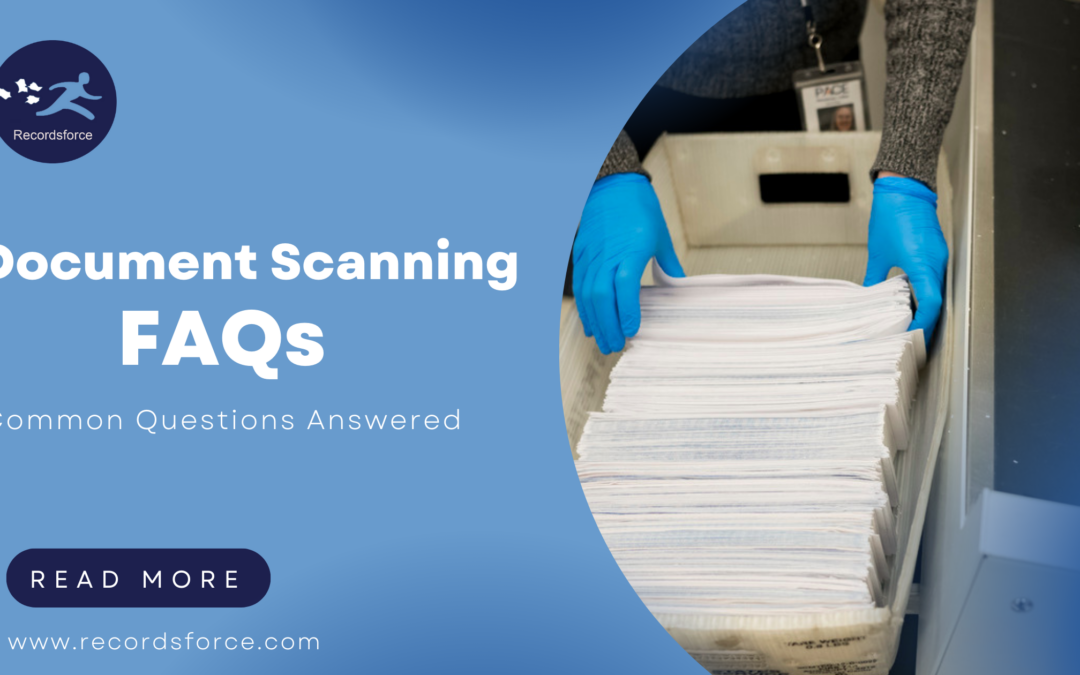Document scanning has become an essential service for businesses looking to streamline their operations, reduce paper clutter, and enhance data accessibility and security. However, as with any service, questions often arise. In this blog post, we will address some of the most common questions about document scanning.
1. What is document scanning, and why do I need it?
Document scanning is the process of converting physical paper documents into digital ones, such as PDFs or image files. It is essential for businesses seeking to:
- Reduce paper storage costs
- Improve document retrieval times
- Enhance data security
- Enable remote access to document and collaboration
- Comply with record-keeping regulations
- Have a disaster recovery plan is place
2. What file formats are used for scanned documents?
The most common file formats for scanned documents are TIFF (Tagged Image File Format) and PDF (Portable Document Format). PDFs are widely used due to their versatility, while TIFFs are preferred for high-quality scans without compression. Your scanning service provider can typically accommodate your preferred format.
3. How much does document scanning cost?
The cost of document scanning varies based on several factors, including the volume of documents, the complexity of the project, and additional services like OCR (Optical Character Recognition), data capture, shredding, etc. Some providers charge per page or per hour, while others offer customized pricing based on your specific needs. It’s essential to request a detailed quote to get an accurate cost estimate.
4. Is OCR necessary?
OCR is a technology that converts scanned text into editable and searchable content. It’s highly beneficial if you want to make your documents searchable or if you plan to edit the content later. Whether OCR is necessary depends on your document management goals.
5. How long does the document scanning process take?
Similarly to cost, the time it takes to complete a document scanning project depends on the volume of documents and the complexity of the project. Small projects can be completed in a matter of days, while larger projects may take several weeks to months. Your scanning service provider should provide you with an estimated timeline based on your project’s specifics.
6. How secure is the document scanning process?
Document scanning service providers take data security very seriously. Your provider should have strict protocols in place to safeguard your documents and data. These protocols should include encryption, secure storage, and access controls. Additionally, they should have a data breach response plan in case of unforeseen events.
7. What happens to my original documents after scanning?
After your documents are scanned, you have a few options. You can request them back, have them securely shredded, or some scanning companies provide on-site storage. Discuss your preferences with your scanning provider to ensure your documents are handled according to your wishes.
8. Can I access my scanned documents remotely?
Yes, one of the benefits of digital documents is the remote access. Once your documents are scanned and delivered via your choice of delivery, you can access them from anywhere with an internet connection. This easily facilitates remote work and collaboration among team members regardless of their location.
9. What happens to my scanned documents in case of technical issues?
Reputable scanning service providers will not only store your physical documents for a few months before shredding in case of emergency, but also have backup systems and redundancy measures in place to mitigate technical issues. In the unlikely event of data loss, they should be able to recover your scanned documents.
In conclusion, document scanning is a versatile solution that can benefit businesses of all sizes and industries. If you have more questions or are considering implementing document scanning services, reach out to our experienced team to discuss your specific requirements and get a tailored solution that fits your needs.

